The microscope eyepiece is a key part of an optical microscope. It helps make the image from the objective lens even bigger. It usually has a power of 10x or 15x, which is important for looking at specimens in biology, medicine, and research. The eyepiece makes the specimen’s image clear and big, so we can study it closely.

Knowing how the microscope eyepiece works is important for seeing things clearly. The eyepiece makes the image from the objective lens bigger. Most compound microscopes have an eyepiece power of 10x. When you use high power lenses with the eyepiece, the total magnification can be over 1000x.
Key Takeaways
- The microscope eyepiece is a key part of an optical microscope, responsible for further magnifying the image produced by the objective lens.
- The ocular eyepiece lens typically has a magnification power of either 10x or 15x.
- The eyepiece function is to provide a clear and enlarged image of the specimen, allowing for detailed examination and analysis.
- Understanding the microscope eyepiece and its function is vital for effective specimen observation.
- The total magnification of a compound microscope can exceed 1000x when combining the eyepiece with high power objective lenses.
- The microscope eyepiece is essential for observing specimens in various fields, including biology, medicine, and research.
Understanding the Microscope Eyepiece Basics
A microscope eyepiece is key to a microscope’s function. It works with the objective lens to magnify the image. The eyepiece is a lens or lenses that make the image bigger.
To grasp the eyepiece’s role, it’s vital to know about eyepiece types and eyepiece components. The eyepiece parts are the eye lens, field lens, and diaphragm. There are Huygenian, Ramsden, and wide-field eyepieces, each with special features for different uses.
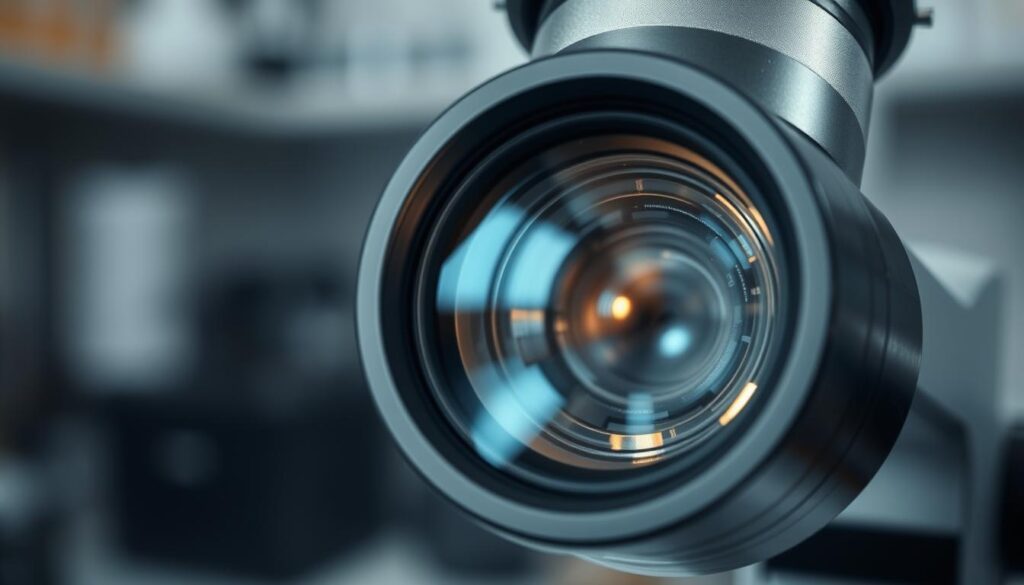
- Finder Eyepiece (PSWH 10X) with field number 26.5
- Widefield Eyepiece (WH 10X) with field number 22
- Super Widefield Eyepiece (SWH 10X) with field number 26.5
Knowing about microscope eyepiece and eyepiece components helps pick the right eyepiece. This ensures your microscope works its best.
| Eyepiece Type | Field Number | Magnification |
|---|---|---|
| Finder Eyepiece | 26.5 | 10X |
| Widefield Eyepiece | 22 | 10X |
| Super Widefield Eyepiece | 26.5 | 10X |
The Primary Function of the Eyepiece on a Microscope
The eyepiece function is key in a microscope. It works with the microscope objective to show a magnified view of the specimen observation. The eyepiece lens makes the image from the objective lens bigger, letting us see details clearly. The quality of the eyepiece greatly affects how well the microscope works.
In compound microscopes, the total magnification is the product of the objective and the eyepiece function. For instance, a 10x objective with a 10x eyepiece function gives a total magnification of 100x. Together, the microscope objective and eyepiece function provide a sharp and detailed view of the specimen observation.
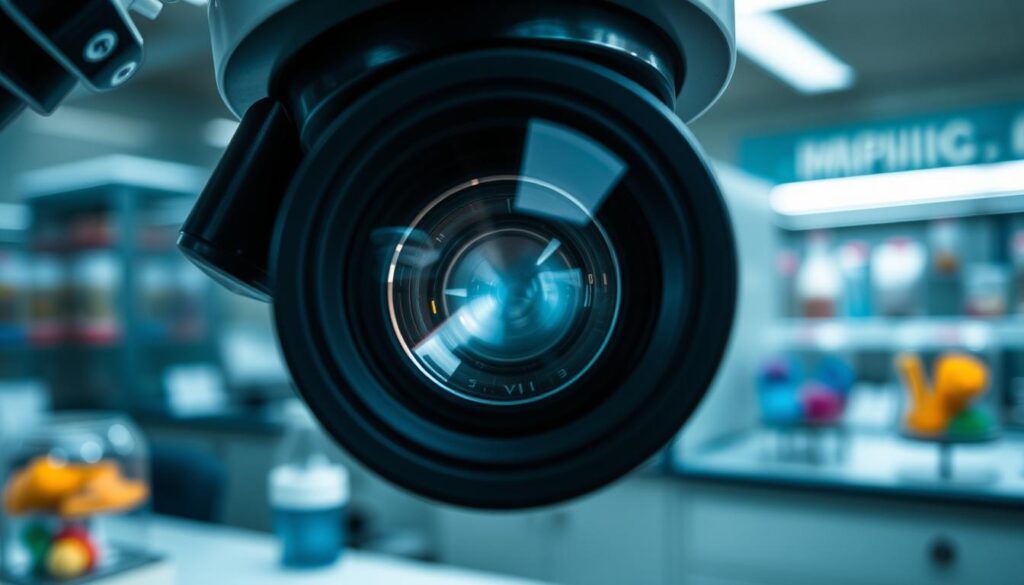
These magnification levels can be mixed with different microscope objective lenses. This allows for a wide range of total magnifications, from 40x to 1000x or more. This depends on the specific needs and specimen observation requirements.
| Microscope Type | Magnification Range |
|---|---|
| Compound Microscope | 40x – 1000x |
| Stereo Microscope | 5x – 40x |
How Microscope Eyepieces Magnify Specimens
Microscope eyepieces are key in making specimens appear larger. They work with the objective lens to show a clear, big image. The eyepiece’s magnification power is found by multiplying the objective lens’s power by its own. This can make the image up to 1000x bigger, depending on the setup.
The field of view matters too. It shows how much of the specimen you can see. A bigger field lets you see more, but a smaller field shows more detail.

Magnification Power Calculation
To find the microscope’s total magnification, multiply the objective and eyepiece magnifications. For instance, a 10x objective with a 10x eyepiece gives you 100x magnification.
Field of View Considerations
The field of view changes with magnification. Higher magnification means a smaller field, while lower means a bigger one.
| Objective Lens Magnification | Eyepiece Magnification | Total Magnification | Field of View |
|---|---|---|---|
| 4x | 10x | 40x | Large |
| 10x | 10x | 100x | Medium |
| 40x | 10x | 400x | Small |
Understanding Eyepiece Specifications
When picking an eyepiece for a microscope, it’s key to look at the eyepiece specifications. The field number shows how wide the view is. The diopter adjustment lets you tweak the focus. Knowing these details helps pick the best eyepiece for your microscope.
A table with info on different eyepieces can be very helpful. It lists field number, diopter adjustment, and notes. This info helps you choose wisely. Important things to think about include:
- Field number: This affects how wide your view is, changing your experience.
- Diopter adjustment: It’s vital for getting sharp images.
- Compatibility: Make sure the eyepiece fits your microscope well.
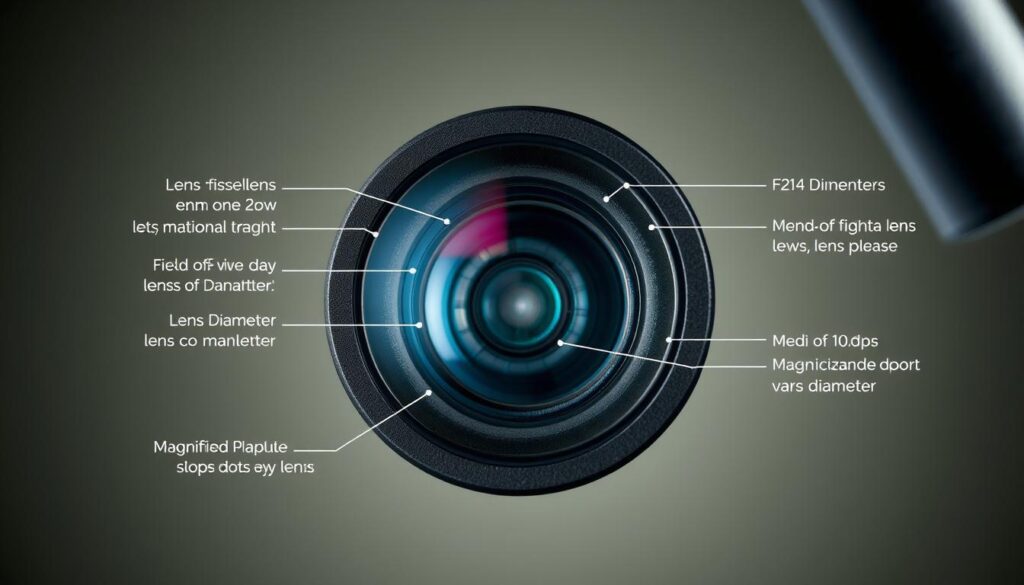
By looking at these points and understanding the eyepiece specifications, you can pick the perfect eyepiece. This is true whether you’re in a lab or teaching. The right eyepiece is key to getting great results.
Different Types of Eyepiece Designs
There are many types of microscope eyepieces, each with special features. Eyepiece designs affect how clear the microscopic image is. Huygenian and Ramsden eyepieces are two common types.
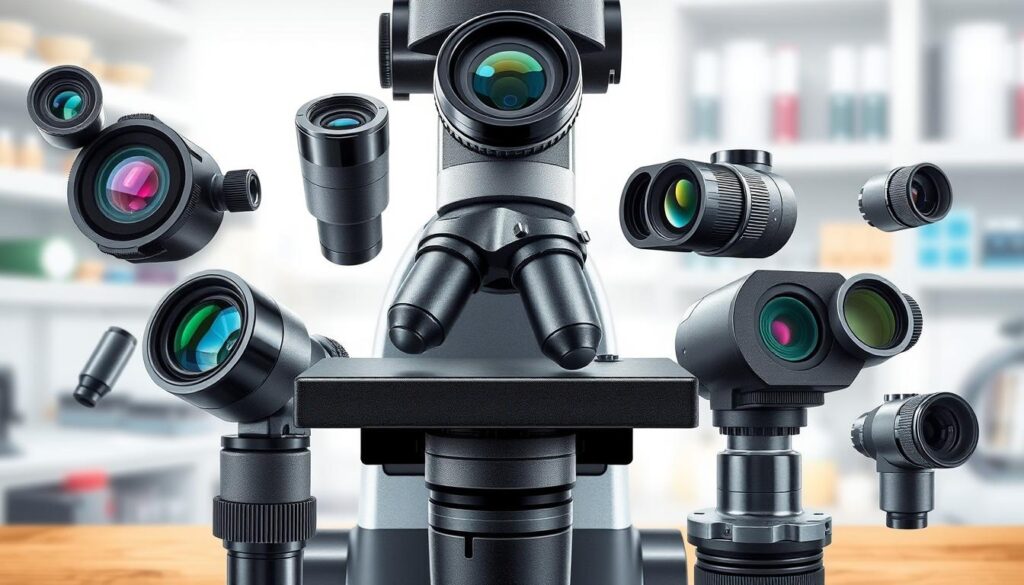
Characteristics of Huygenian and Ramsden Eyepieces
- Huygenian eyepieces have a narrow field of view and are found in older microscopes.
- Ramsden eyepieces have a wider field of view and are used in modern microscopes.
Other eyepiece designs include wide-field eyepieces. These improve the viewing area and are great for long observations. The right eyepiece depends on the task and the needed magnification and image quality.
| Eyepiece Design | Field of View | Magnification |
|---|---|---|
| Huygenian | Narrow | 10x-20x |
| Ramsden | Wider | 10x-20x |
| Wide-field | Enhanced | 10x-20x |
The Role of Eye Relief in Microscope Viewing
Eye relief is key in microscope use, affecting comfort and usability. It’s the space between the eyepiece and your eye. A longer relief is better for those with glasses, while a shorter one suits those with smaller eyes.
For microscope use, user comfort is vital. A microscope with good eye relief reduces eye strain. This lets users focus on their samples for longer. A microscope with too little relief can cause discomfort and tired eyes. It’s important to pick a microscope with an eyepiece that feels right.
Some important things to think about for microscope viewing include:
- Eye relief: The distance between the eyepiece lens and the user’s eye.
- Field of view: The area that can be seen through the microscope.
- Magnification: The ability to enlarge the specimen for closer observation.

In summary, eye relief is very important in microscope use. It affects the image quality and user comfort. By choosing a microscope with the right eye relief and considering other factors, users can improve their microscope experience. This helps them reach their research goals.
| Microscope Type | Eye Relief | Field of View | Magnification |
|---|---|---|---|
| Compound Microscope | 10-15mm | 1-5mm | 40-1000x |
| Stereo Microscope | 50-70mm | 10-50mm | 5-40x |
Proper Care and Maintenance of Microscope Eyepieces
Microscope eyepieces need regular care to work well and last long. Eyepiece care helps avoid damage and keeps images clear. Taking good care of your microscope can make it work up to 20% better.
Cleaning the eyepiece and lenses often is key. Use a soft cloth and a mild cleaner to avoid harming the coatings. Also, keep the microscope in a dry place to stop moisture damage.
Cleaning and Storage Requirements
Cleaning the eyepiece and lenses monthly is a good rule. A mix of 40% petroleum ether, 40% ethanol, and 20% ether can make your observations clearer by 20%. Storing the microscope in a sealed bag with silica gel can cut down moisture damage by 40%.
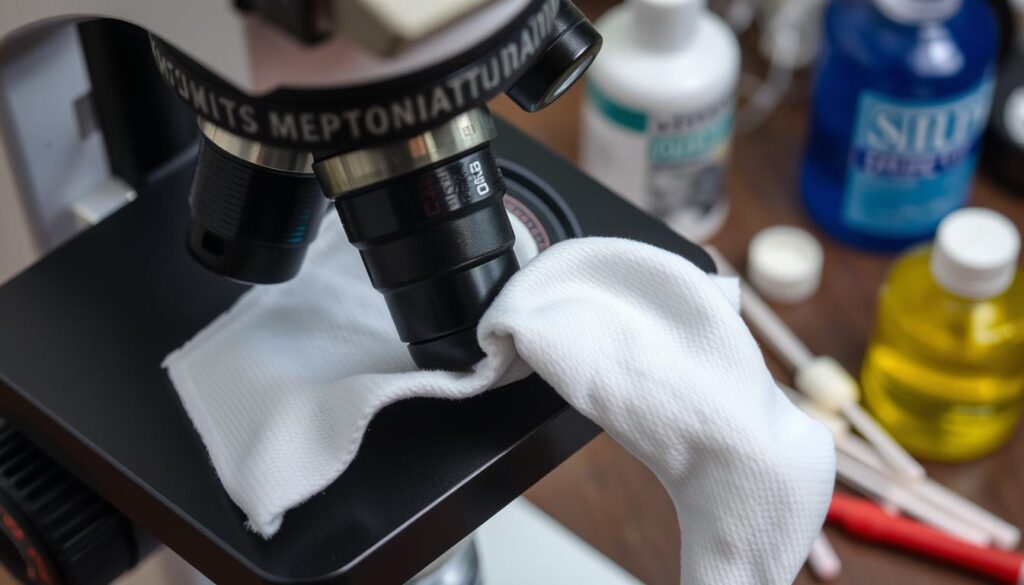
Common Maintenance Issues
Problems like dust, contamination, and bad cleaning are common. Wearing gloves and using a dust cover can help keep it clean. Regular care and cleaning can also save you about 30% on repair costs, making your microscope last longer.
Selecting the Right Eyepiece for Your Microscope
Choosing the right eyepiece is key. You need to think about microscope compatibility and the different eyepiece types. The type of eyepiece you pick depends on your microscope and what you’re looking at.
It’s important to make sure the eyepiece fits your microscope right. This ensures the best image quality. Also, different eyepieces offer different views and magnifications.
Here are some things to keep in mind when picking an eyepiece:
- Interpupillary distance: This is the space between your pupils, usually between 54 mm to 74 mm.
- Diopter adjustment: About 60% of people need to adjust for differences in eye strength.
- Field of view: A WF10X/22 eyepiece gives a view of about 22 mm, great for seeing big things.
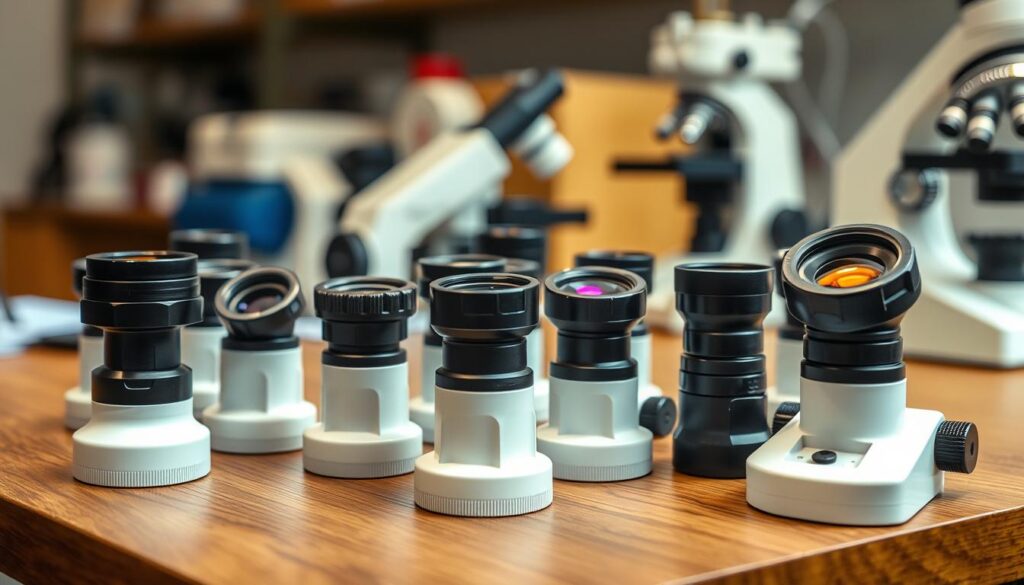
By thinking about these points and picking the right eyepiece types, you’ll get the best results. Also, make sure your eyepiece fits your microscope well.
Common Problems with Microscope Eyepieces
Microscope eyepieces can face many issues that harm the image quality and microscope performance. Eyepiece problems like focusing issues and image distortion can really affect how well you can see. For example, focusing problems might come from not adjusting the eyepiece or objective lens right, making the image blurry.
Some common issues with microscope eyepieces include:
- Focusing issues: This can be due to incorrect adjustment or a problem with the eyepiece itself.
- Image distortion: This can be caused by poor quality eyepieces or incorrect alignment.
- Alignment problems: This can affect the accuracy of the image and the overall performance of the microscope.
It’s key to understand and fix these eyepiece problems for the best microscope use. By knowing what causes focusing issues and image distortion, users can take steps to fix them. This ensures a clear and accurate image.

| Issue | Cause | Solution |
|---|---|---|
| Focusing issues | Incorrect adjustment or eyepiece problem | Adjust the eyepiece or replace it if necessary |
| Image distortion | Poor quality eyepieces or incorrect alignment | Use high-quality eyepieces and ensure proper alignment |
Advanced Features of Modern Microscope Eyepieces
Modern microscope eyepieces come with advanced designs that boost their performance and ease of use. They have digital integration, which lets you take digital images and videos. This is super helpful in research and education, where you need to document and analyze samples.
These eyepieces also have an ergonomic design. This design makes them comfortable to use and reduces eye strain. They often have adjustable features like interpupillary distance and eye relief. These are great for people with different vision needs.
The benefits of advanced eyepieces include:
- Improved image quality and resolution
- Enhanced comfort and reduced eye strain
- Increased versatility and flexibility in viewing specimens
- Ability to capture digital images and videos
Modern microscope eyepieces are also made to work well with many microscopes and accessories. This makes it easy to upgrade or change your microscope setup. With the latest in digital integration and ergonomic design, these eyepieces are key for anyone using microscopes.
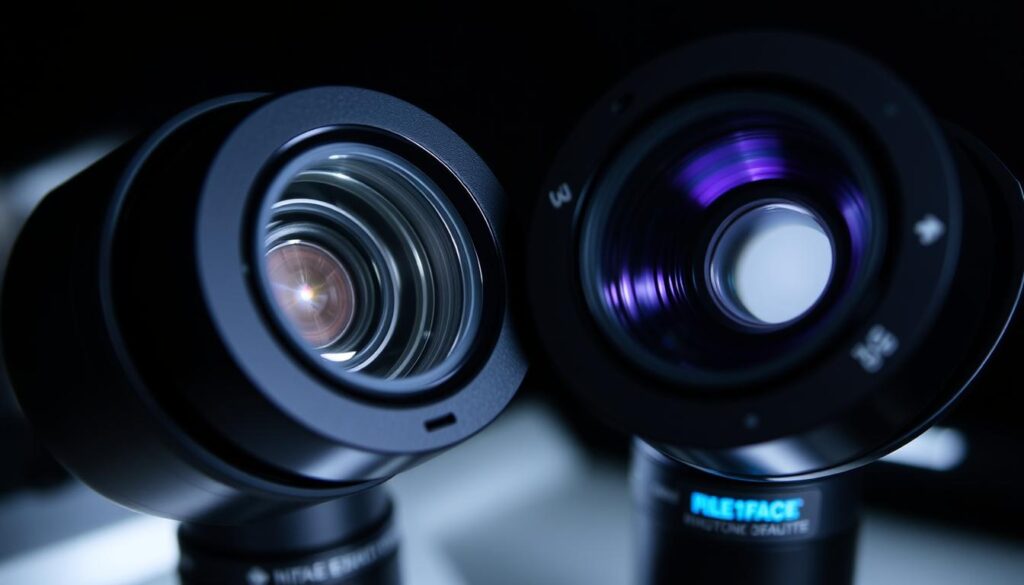
Digital Integration with Traditional Eyepieces
Digital integration with traditional eyepieces has changed microscopy a lot. It lets users take digital images and videos easily. Digital eyepiece technology adds a digital part to the eyepiece. This makes it better for things like image processing and analysis.
One big plus is camera adaptation. It lets you attach cameras to the microscope. This way, you can take clear images and videos. These are great for teaching, research, and checking quality.
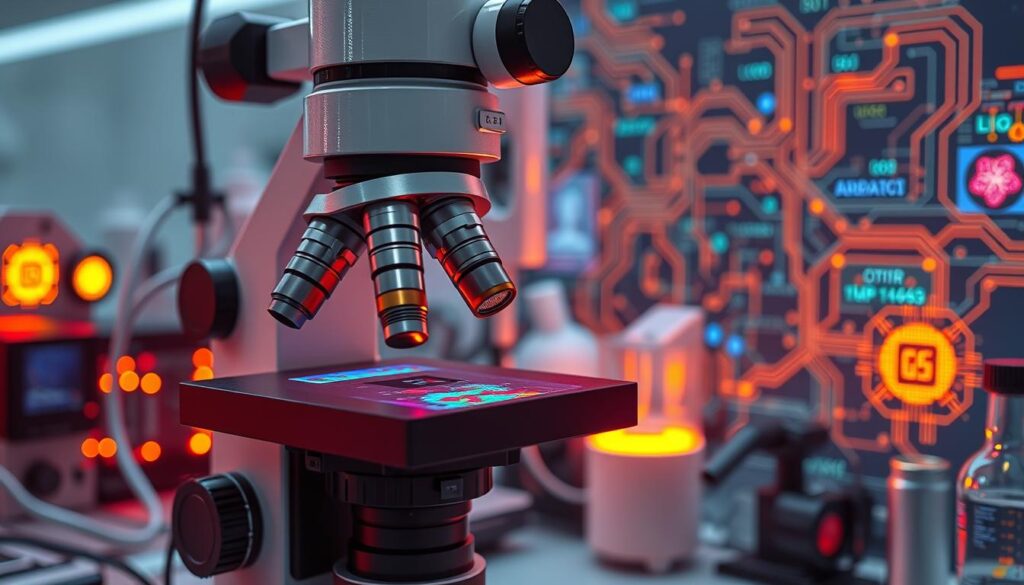
Benefits of Digital Integration
- Enhanced functionality, including image processing and analysis
- Ability to capture and share digital images and videos
- Improved collaboration and communication among users
In short, digital integration with traditional eyepieces is very useful. It makes microscopy better by using digital integration, camera adaptation, and digital eyepiece technology. Users can now capture, analyze, and share images and videos more easily.
| Feature | Description |
|---|---|
| Digital Eyepiece Technology | Provides a digital interface for the eyepiece, allowing for enhanced functionality |
| Camera Adaptation | Enables the attachment of cameras to the microscope, allowing for high-quality image and video capture |
| Digital Integration | Allows for the capture and sharing of digital images and videos, enriching collaboration and communication among users |
Ergonomic Considerations for Eyepiece Usage
Using a microscope means you need to think about the eyepiece’s design. It should be comfy and easy to use. The eye relief and interpupillary distance should adjust to fit different people. This helps avoid eye strain and makes viewing more enjoyable.
When looking at an eyepiece, consider its weight and balance. A balanced microscope helps avoid neck and back pain. An adjustable eyepiece fits users with different eye distances. Good design means you can work for longer without getting tired.
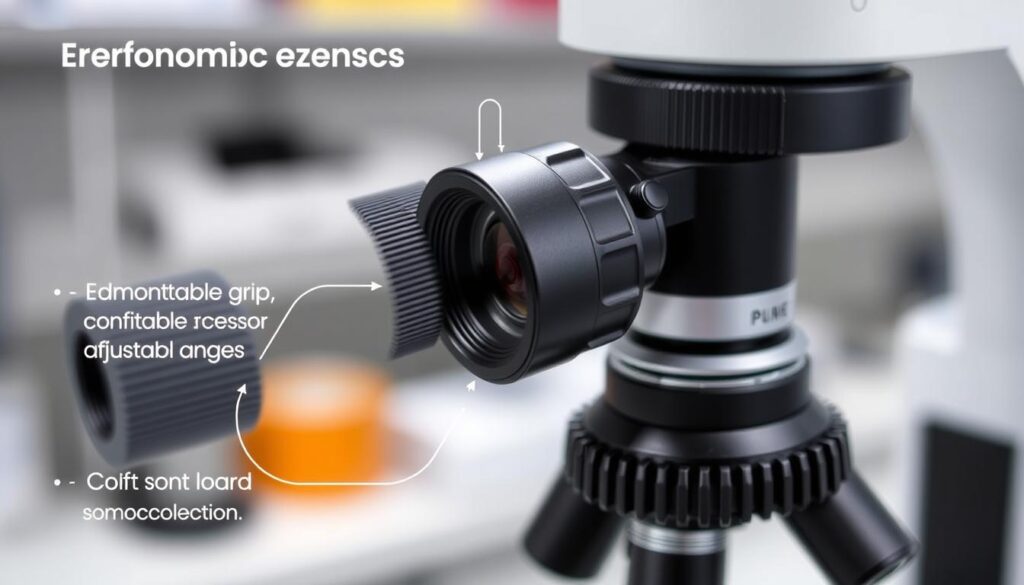
Eye relief and interpupillary distance are also key. The eye relief lets you see without eye strain. The interpupillary distance should adjust for everyone. These features make viewing more comfortable and productive.
| Ergonomic Factor | Importance |
|---|---|
| Eye Relief | High |
| Interpupillary Distance | High |
| Weight and Balance | Medium |
Focus on ergonomic design and eye relief, interpupillary distance. This makes viewing comfy and productive. It also lowers the chance of musculoskeletal problems.
Compatibility Issues Between Eyepieces and Microscopes
Choosing the right eyepiece for your microscope is key. You need to think about threading standards and size specs. This ensures your eyepiece works well with your microscope.
Threading standards like RMS and M25 are important. The eyepiece’s size, like diameter and focal length, must match your microscope. Proper selection of eyepieces affects the quality of your view, including how well it corrects for aberrations.
Threading Standards
Threading standards are vital for eyepiece and microscope compatibility. Different makers use different threads. Always check before you buy.
Size Specifications
Size matters too. The eyepiece’s diameter and focal length must fit your microscope. The objective’s numerical aperture (NA) affects image quality, ranging from 0.25 to 1.4.
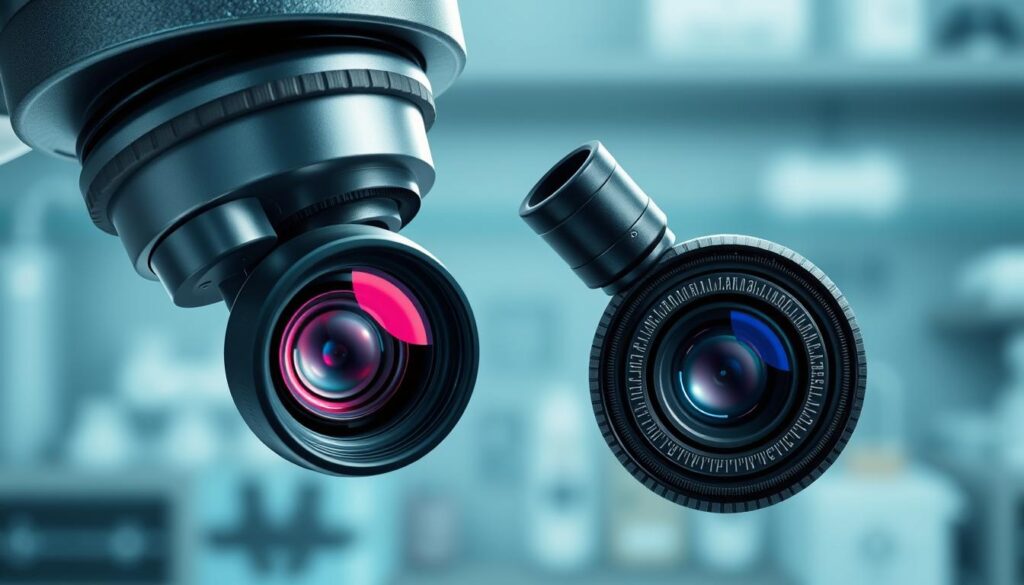
To avoid problems, pick eyepieces from trusted brands. They should give clear specs and compatibility info. This way, you get the best out of your microscope.
| Threading Standard | Size Specification | Compatibility |
|---|---|---|
| RMS | 23mm diameter | Compatible with most microscopes |
| M25 | 25mm diameter | Compatible with some microscopes |
Tips for Optimal Eyepiece Performance
To get the best out of your eyepiece performance, keep it clean and well-maintained. Regular care stops damage and keeps it working well. Just wipe it gently with a soft cloth to remove dust or debris.
Here are some more tips for the best eyepiece use:
- Choose the right eyepiece for your needs.
- Always follow the maker’s cleaning and care tips.
- Keep your microscope and eyepiece in a dry, cool spot.
By sticking to these tips, you’ll get the most out of your eyepiece performance. Regular microscope maintenance and cleaning procedures are key to success.

| Maintenance Task | Frequency |
|---|---|
| Dusting the eyepiece | Daily |
| Cleaning the eyepiece | Weekly |
| Checking the eyepiece for damage | Monthly |
Conclusion
The eyepiece is key to a microscope’s success. Knowing about different eyepieces and how to take care of them helps users get the most out of their microscope. Each type, from simple to advanced, has its own benefits for different needs.
Choosing the right eyepiece is important. It affects how clear and detailed the images are. Regular cleaning and maintenance of the eyepiece lens also play a big role. By following these tips, users can fully enjoy their microscope and explore the world around them.
FAQ
What is the primary function of the eyepiece on a microscope?
The eyepiece on a microscope makes the image from the objective lens bigger. This lets us see details of specimens clearly.
How does the eyepiece work in combination with the objective lens to magnify specimens?
The eyepiece makes the image from the objective lens even bigger. The total magnification is the product of the eyepiece and objective lens magnifications.
What factors should be considered when choosing the right eyepiece for a microscope?
When picking an eyepiece, think about the field number, diopter adjustment, and if it fits your microscope.
What are the different types of eyepiece designs, and how do they differ in their applications?
There are Huygenian, Ramsden, and wide-field eyepieces. Each has its own features and is best for certain uses.
How important is eye relief in microscope viewing, and how does it impact the user’s experience?
Eye relief is key for comfort when using a microscope. It affects how easy it is to see, depending on your eye size and if you wear glasses.
What are some common problems that can arise with microscope eyepieces, and how can they be addressed?
Issues like focusing problems and image distortion can happen. Cleaning and making sure the eyepiece fits right can solve these problems.
What are some advanced features found in modern microscope eyepieces, and how do they enhance the user experience?
New eyepieces have cool features like digital integration for photos and videos. They also have ergonomic design for comfort and less eye strain.
How can the compatibility between eyepieces and microscopes affect the performance and usability of the microscope?
If an eyepiece doesn’t fit right, it can mess up the microscope’s performance. Make sure the eyepiece matches your microscope’s threading and size.
What are some tips for achieving optimal eyepiece performance on a microscope?
For the best results, keep your microscope clean and use the right eyepiece for the job. Always follow the manufacturer’s guidelines.